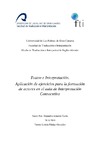Please use this identifier to cite or link to this item:
https://accedacris.ulpgc.es/jspui/handle/10553/70248
| DC Field | Value | Language |
|---|---|---|
| dc.contributor.advisor | Fidalgo González, Leticia María | es |
| dc.contributor.author | Almeida Tavira, Francisco Alejandro | es |
| dc.date.accessioned | 2020-02-12T17:32:47Z | - |
| dc.date.available | 2020-02-12T17:32:47Z | - |
| dc.date.issued | 2019 | - |
| dc.identifier.uri | https://accedacris.ulpgc.es/handle/10553/70248 | - |
| dc.description.abstract | Tanto en el teatro como en la interpretación de conferencias, el actor y el intérprete deben enfrentarse a dificultades muy similares y necesitan competencias semejantes. Nuestro objetivo ha sido aplicar en el aula de Interpretación Consecutiva ejercicios que se emplean para la formación de actores para ayudar a que los futuros intérpretes adquieran competencias que les permitan, por ejemplo, gestionar mejor el estrés, solucionar problemas de manera creativa, hablar con mayor seguridad en público, controlar sus reacciones y emociones, ser conscientes de los elementos no verbales que influyen en la comunicación, entre otros. Para ello, estudiamos algunas de las destrezas con las que debe contar el intérprete, analizamos las dificultades a las que se enfrenta, estudiamos los fundamentos teóricos de ambas disciplinas y las confluencias entre ellas. Por último, analizamos los resultados que hemos obtenido a través de dos cuestionarios que los alumnos han tenido que realizar antes y después de los ejercicios. | en_US |
| dc.description.abstract | In both theatre and conference interpreting, actors and interpreters must confront verysimilar difficulties and require very similar skills. The aim of this study has been to apply exercises used in actor training to consecutive interpreting clases, in order to help future interpreters to overcome obstacles and acquire skills. These skills allow them, for example, to better manage stress, creatively solve problems, speak more confidently in public, control their reactions and emotions, and be aware of non-verbal elements that affect communication. To this end, some of the skills interpreters should have are studied, the difficulties they must contend with are analysed, a theoretical review of both disciplines is carried out, and their confluences examined. Finally, the results of two questionnaires carried out by the students before and after the exercises are analysed and mcompared. | en_US |
| dc.language | spa | en_US |
| dc.subject | 570113 Lingüística aplicada a la traducción e interpretación | en_US |
| dc.subject.other | Actores y actrices | es |
| dc.subject.other | Traducción | es |
| dc.subject.other | Intepretación consecutiva | es |
| dc.title | Teatro e Interpretación. Aplicación de ejercicios para la formación de actores en el aula de Interpretación Consecutiva | es |
| dc.type | info:eu-repo/semantics/bachelorThesis | en_US |
| dc.type | BachelorThesis | en_US |
| dc.contributor.departamento | Departamento de Filología Moderna, Traducción E Interpretación | es |
| dc.contributor.facultad | Facultad de Traducción e Interpretación | en_US |
| dc.investigacion | Artes y Humanidades | en_US |
| dc.type2 | Trabajo final de grado | en_US |
| dc.utils.revision | Sí | en_US |
| dc.identifier.matricula | TFT-55120 | es |
| dc.identifier.ulpgc | Sí | es |
| dc.contributor.titulacion | Grado en Traducción e Interpretación: Inglés-Alemán | es |
| item.fulltext | Con texto completo | - |
| item.grantfulltext | open | - |
| crisitem.advisor.dept | GIR Traducción e Interpretación, Interculturalidad, Lenguas Aplicadas y Literatura de Viajes | - |
| crisitem.advisor.dept | Departamento de Filología Moderna, Traducción e Interpretación | - |
| Appears in Collections: | Trabajo final de grado | |
Page view(s)
254
checked on Aug 12, 2023
Download(s)
9,518
checked on Aug 12, 2023
Google ScholarTM
Check
Share
Export metadata
Items in accedaCRIS are protected by copyright, with all rights reserved, unless otherwise indicated.

